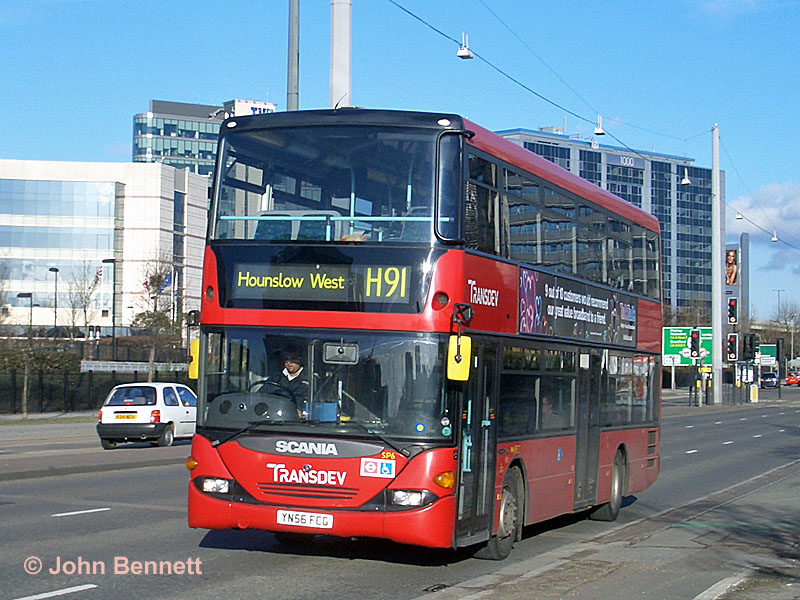 | Photo © John Bennett. |
Home | Bus routes | Operational details | Service changes | Operators & Garages | Photo gallery
Although the number H91 itself only dates back to 1991, its origins go back much further; the route replaced the main section of the old 91 service between Hounslow West and Hammersmith via the Great West Road. When inevitably the time came for the 91 to be split, the section between Hammersmith, Fulham and Wandsworth Bridge was lost, although Turnham Green - Hammersmith - Fulham was (and still is) covered by another new route, the 391. Going back considerably further, the route used to run a little beyond Hounslow West to Cranford. The Great West Road was also for many years without a Sunday service, although this has recently been restored.
The H91 was formed as part of the major “Harrier” midibus scheme in London United’s south west London territory, using early model Dennis Darts. The H prefix letter stands for all sorts of things around London; probably not Harrier, as some Harrier routes had R prefixes (for Richmond), but, apart from Hampstead and Harrow, there are Hounslow, Hanworth, Hatton (Cross), Heathrow, Hammersmith, Hayes and Heston! The H91 does not actually serve Hounslow, though it passes within walking distance on the Great West Road.
Therefore you may take your pick out of Hounslow, Heston or Hammersmith to explain the H91, but whereas most routes in the Hounslow area were numbered H2x, one route H98 was so numbered as a replacement for the 98, and H91, H37 and H32 soon followed suit to replace parts of the 91, 37 and 232.
Since then, there have been several type changes. After London United purchased Westlink, the H91 was moved to Westlink’s Hounslow Heath base, and slightly larger Wright bodied Darts became common for a while. Low floor operation was achieved using LLW class Dennis Lances cascaded from route 120 in 2000: The 120 had been the very first low floor bus route in London (excepting Omni-operated H20 and Carelink routes) when the Lances arrived early in 1994. But it had been a conversion from double deck operation, and the Lances were never very suitable, and a new contract saw that route revert to double deck operation.
The Lances swept away quite a wide collection of types from the H91, including MCW Metrobuses, Leyland Olympians at least one Lynx, and a variety of lengths and shapes of standard and low floor Darts – some in the special liveries for routes 216, 555/6/7 or T123 – basically anything available at the route’s home garage! However, there were no spare Lances, so frequent substitutions by other types continued. During this period, the H91 spent a good year at Stamford Brook garage after the 285 was taken on at Hounslow Heath, although it later moved back after routes 272 and 440 were introduced at Stamford Brook.
However, the Lances were not very popular either with passengers or the company’s engineers, being the most unreliable buses in the fleet. A new contract commencing in March 2004 specified later Darts – not new ones, but vehicles cascaded from route 49, which it was anticipated would receive double deckers later in the year. These were DP class 10.7m long vehicles.
A further contract was awarded in 2009 and called for new buses, but whether double deck or single deck was not specified. The route had been having capacity issues, so double deckers were desired, but TfL felt this should be funded by businesses in the Brentford area whose employees were the main cause of crowding. As no decision was made the route had to continue with existing single deckers for a while, but TfL felt that the DPs were too old, so they were replaced by newer DPSs that had been displaced from route 283, lost to NSL Services. The DPSs are shorter at 10.1m, which is rather perverse when an increase in capacity was what was needed – but it kept TfL happy!
Fortunately the double deck conversion was eventually agreed, and early SPs displaced from route 148 are forming a second temporary allocation pending delivery of the new double deckers originally promised. In any sane operation these buses, which are only 3 years old themselves, could perfectly well have formed the permanent allocation; however, TfL do not like them as they are built to a lower height than normal! This is the reason they were displaced from the 148 in the first place; what will happen to them in the long term remains to be seen. Anyhow, for a few months they are on the H91, and thus we have SP6 (YN56 FCG) travelling (westwards) along the Great West Road, Brentford on Saturday 30 January 2010. It had just left the bus stop after the crossroads with Boston Manor Road; the building to the left of the bus is GlaxoSmithKline's headquarters, presumably one of those responsible for the heavy loadings!
 | Photo © John Bennett. |
Navigation
| Previous | Next | |
| Chronologically | 505 | 931 |
| Numerically | H37 | K1 |
Photo Gallery | Bus route list | Operational details | Service changes | Operators & Garages